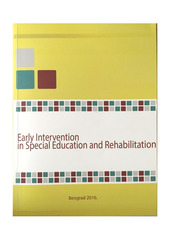Приказ основних података о документу
Sensory processing in children with developmental disabilities
| dc.contributor | Nikolić Snežana | |
| dc.contributor | Nikić Radmila | |
| dc.contributor | Ilanković Vera | |
| dc.creator | Đurić-Zdravković, Aleksandra | |
| dc.creator | Japundža-Milisavljević, Mirjana | |
| dc.creator | Gagić, Sanja | |
| dc.date.accessioned | 2021-06-17T13:23:34Z | |
| dc.date.available | 2021-06-17T13:23:34Z | |
| dc.date.issued | 2016 | |
| dc.identifier.isbn | 978-86-6203-086-3 | |
| dc.identifier.uri | http://rfasper.fasper.bg.ac.rs/handle/123456789/2523 | |
| dc.description.abstract | Mutual integration of different sensory information enables interpretation of environmental stimuli. In children with developmental disability inadequate sensory processing is present in various degree. Emersion of sensory processing difficulties is dominant at earliest of age, so early detection is extremely important for rehabilitation treatment. Aim of this research is to determine at which part of sensory processing, difficulties occur in children with developmental disabilities, and whether there is a difference in sensory processing between children with autism spectrum disorder (ASD) and in intellectually disabled children (ID). Sample consisted of 61 examinee age four to six, both genders, divided in two groups. First group consisted of 42 examinees with ASD, and in the second group consisted of 19 ID children. Excluding criteria for forming the sample was existence of other medical or psychological diagnosis, neurological diseases and sensory damages. Short sensory profile was used for acquiring the data necessary for screening of sensory processing difficulties (The Short Sensory Profile, Dunn, 1999). In research results difficulties in certain aspects of sensory processing in children with ASD and in ID children are shown through percentage. In all instruments of subtest, more frequent sensory processing difficulties occur in children with ASD than in ID children. The difference in arithmetic mean between children’s scores with ASD and children’s scores with ID on screening of sensory processing difficulties is existent and it is statistically relevant (t=3.544, df=59, p=0.001). | |
| dc.language | sr | |
| dc.publisher | University of Belgrade, Faculty of Special Education and Rehabilitation, Serbia / Univerzitet u Beogradu – Fakultet za specijalnu edukaciju i rehabilitaciju | |
| dc.rights | openAccess | |
| dc.rights.uri | https://creativecommons.org/licenses/by-sa/4.0/ | |
| dc.source | Thematic Collection of International Importance- Early Intervention in Special Education and Rehabilitation“, Beograd, Srbija, 2016. | |
| dc.subject | sensory processing | |
| dc.subject | intellectual disability | |
| dc.subject | autism spectrum disorder | |
| dc.title | Sensory processing in children with developmental disabilities | en |
| dc.type | conferenceObject | |
| dc.rights.license | BY-SA | |
| dc.citation.epage | 221 | |
| dc.citation.other | : 209-221 | |
| dc.citation.rank | M14 | |
| dc.citation.spage | 209 | |
| dc.identifier.fulltext | http://rfasper.fasper.bg.ac.rs/bitstream/id/6274/Untitled15.pdf | |
| dc.identifier.rcub | https://hdl.handle.net/21.15107/rcub_rfasper_2523 | |
| dc.type.version | publishedVersion |


